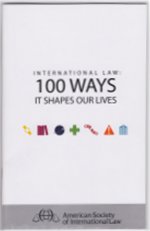 Driving freely and legally in another country. Being able to recognize traffic and road signs in more and more countries around the world.
Driving freely and legally in another country. Being able to recognize traffic and road signs in more and more countries around the world.
By: James G. Apple, Editor-in-Chief, International
Judicial Monitor
(In celebration
of the 100th anniversary of the founding of the American Society of
International Law in 2006, the Society published a pamphlet titled International
Law: One Hundred Ways It Shapes Our Lives. The introduction gives an
explanation for its conception: an affirmation that: “international law not
only exists, but also penetrates much more deeply and broadly into everyday
life than the people it affects may generally appreciate.” This column seeks to
elucidate and elaborate on many of the 100 ways briefly presented in the ASIL
pamphlet.)
International travel by personal private car has been made
easier in the past 60 years not only by being able to transport private
cars by container and other kinds of ships, but also by international
agreements relating to the use of personal drivers’ licenses and the creation of
a uniform system of road signs.
I personally was able to avail myself of both new freedoms
in the late 1980s when I was studying in Europe for a year and was able to have my
own personal automobile transported from the United States to a port in England.
I was amazed at the ease with which I arranged for the transport of my car
across the Atlantic both coming and going from the U.K. There was
very little paper work involved, and no complications in picking up the vehicle at
the two destinations, and modest fees. I used my car continuously in driving around
England and Scotland with both my personal driver’s license from a U.S. state,
and an international driver’s license.
Numerous international treaties relating to carriage of
goods by sea (including containers) and by road enable the use of ships to
transport private cars to another country and also enable the use of roads
crossing borders for ease of movement of private cars. Examples of such
treaties are the Customs Convention on Containers (1956,1962) and the Customs
Convention on the Temporary Importation of Private Road Vehicles (1964).
The use of a valid driver’s license and being able safely to
understand the roads of another country by using standardized road signs are
made possible by two United Nations conventions, the 1949 UN Convention on
International Road Traffic (known as the Geneva Convention on Road Traffic) and
the 1968 UN Convention on Road Traffic (known as the Vienna Convention on Road
Traffic).
The first convention allows residents of one country holding
a valid driver’s license to apply for and receive an international driver’s
license.
The second convention, which was signed in November, 1968
and came into force in May, 1977, allows drivers from other countries to
understand the road signs of the country where the visitor is driving. The
Convention has been signed by 74 countries.
It should be noted that these conventions for motorists
driving their personal cars have standard requirements that must be met, such
as display of registration, license plates and carrying of the vehicle’s
registration certificate. It should also be noted that the United States and
China are non-signatories to these conventions.

 International
Judicial Monitor
International
Judicial Monitor